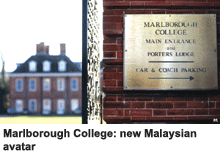One corner of a foreign field is becoming forever England. It is in Johor on the southernmost tip of peninsular Malaysia, opposite Singapore. At a site called Nusajaya, workmen are finishing a new campus of Newcastle University. Nearby foundations are being dug for Southampton University. And down the road Marlborough College, one of England’s most famous public (that is, private) schools, is building a Malaysian campus from scratch. If all goes well, its 900 pupils will hardly notice that they are looking out over palm-oil plantations rather than the Wiltshire Downs. Within a few years thousands of students will be enjoying an English education in this steamy bit of Asia.
 Educity, as the Johor complex is called, reflects Malaysia’s grand strategy to become a centre for Western education. The country wants to meet strong demand among Asia’s new middle classes for English-language schooling. It also worries about its brain drain (over 300,000 university-educated Malays work abroad). Having watched Asian children flock West to spend a lot of money on British and American schools, the government decided a few years ago to try and reverse the trend. It has campaigned to persuade Western schools and colleges to come and set up branch campuses. The Malaysian proposition to Asian parents is simple and beguiling: come to these famous schools and universities in our country and get the same degrees and qualifications as in Britain or America for half the price.
Educity, as the Johor complex is called, reflects Malaysia’s grand strategy to become a centre for Western education. The country wants to meet strong demand among Asia’s new middle classes for English-language schooling. It also worries about its brain drain (over 300,000 university-educated Malays work abroad). Having watched Asian children flock West to spend a lot of money on British and American schools, the government decided a few years ago to try and reverse the trend. It has campaigned to persuade Western schools and colleges to come and set up branch campuses. The Malaysian proposition to Asian parents is simple and beguiling: come to these famous schools and universities in our country and get the same degrees and qualifications as in Britain or America for half the price.
Australia’s Monash University was the first to set up shop, followed by Britain’s Nottingham University, in 2000. Other Australian universities followed Monash, and in March the Massachusetts Institute of Technology teamed up with a Malaysian body to create Asia’s first Institute for Supply-Chain Innovation. Johns Hopkins University is expected to set up a medical school. The Netherlands Maritime Institute of Technology is already in Educity.
For these Western institutions, the prize is a toehold in the world’s biggest education market. Many have already gone into partnership with or lent their names to schools and universities in Hong Kong, Singapore and Shanghai. But this is the first time so many have been persuaded to build replicas of themselves in another country, a more permanent and riskier proposition. They are doing so largely because the Malaysian government is bearing the start-up costs. Educity is spending about $100 million (Rs.450 crore) on infrastructure and buildings.
Yet other factors count as well. Malaysia is a former British colony and English is widely spoken. The country has a superficially Western feel to it — ideal for Westerners studying or teaching in Asia, and for Asians who want to acclimatise to Western culture. Meanwhile, Malaysia cleverly markets itself to the Middle East as a relatively relaxed Islamic country where young Muslims can mix freely together and, for a few years, slip the surly watch of the morality police back home.
In return for putting up a lot of money, the Malaysian government wants universities to set up faculties in subjects that will be most useful to Malaysia. The University of Southampton, for instance, will only offer degrees in engineering. But the influx of foreign colleges might have more interesting consequences too. To attract foreign universities, the government has had to waive the restrictive and sometimes racist regulations that govern Malaysia’s own universities. In these places, informal quota systems give preference to ethnic Malays in the faculties of sought-after subjects such as law, medicine and engineering. Students are not allowed to join political parties or protest.
Now, local students are demanding to know why they should be subject to these archaic rules when the new students are not. Good question.
(Excerpted and adapted from Times Higher Education)